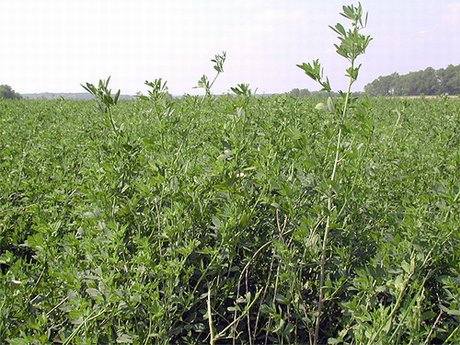
Food plots go hand-in-hand with most properties practicing white-tailed deer management. Alfalfa can be one of the many plant species used to provide supplemental food for your whitetail herd. Most hunters do not know this, but there are over 205 varieties of alfalfa! Which one is right for your property and deer? For those landowners and hunters looking to plant and establish an alfalfa food plot, this article covers information that can help you learn more about high-quality alfalfa.
Alfalfa varieties with the best forage quality will be marked high quality (HQ) or multifoliolate (ML). These select varieties have high yield, are resistant to insects and heavy grazing, and are somewhat winter hardy. Because there are so many varieties of alfalfa, there are a lot of differents between alfalfa varieties. The key is finding the variety that is best-suited for your ranch.
Alfalfa varieties are rated for fall dormancy and winter hardiness and these factors can help you select the best variety for your property. Most of these ratings relate to latitude and the length of the growing season in your area. Fall dormancy relates to how soon the variety stops growing in the fall and how early it begins growing again in the spring. Winter hardiness is how well a variety will survive over multiple winters. A high winter hardiness means that a particular variety of alfalfa will live much longer (years) than other varieties. However, it also means that the plant will go dormant earlier in the year, which means less forage production and supplemental feed for your whitetail.
The time and length of dormancy affect the amount of forage an alfalfa variety will produce. Varieties that go dormant in early fall are more winter hardy than non-dormant varieties, but alfalfa varieties with a long dormancy grow for fewer months of the year. This means winter-hardy varieties tend to produce less forage than alfalfa varieties with a short dormancy. Winter hardiness is the most important factor that determines how long your whitetail food plot will survive, how much forage it will produce, and how often you will have to replant.
If planting alfalfa food plots at southern latitudes, fall dormancy ratings can be between 3.0 and 10.0. If planting food plots in the north, select varieties that have a fall dormancy rating between 2.0 and 4.5, and a winter hardiness rating of 3.0. Make sure you talk to your local seed dealer or wildlife biologist to get recommendations on the alfalfa varieties that perform best in your area. Alfalfa plots take more work than your standard oat or wheat food plot, but they can help you in your deer management efforts and keep your deer herd in great shape!